Book contents
- The Life Course in Old English Poetry
- Cambridge Studies In Medieval Literature
- The Life Course in Old English Poetry
- Copyright page
- Dedication
- Contents
- Figures and Tables
- Acknowledgements
- A Note on the Chronology of Old English Poetry
- Abbreviations
- Introduction The Poetics of the Life Course
- Chapter 1 Taking Shape
- Chapter 2 Becoming Useful
- Chapter 3 Outliving Others
- Chapter 4 Getting Wasted
- Conclusion The Rhyming Poem
- Notes
- Bibliography
- Index
- Cambridge Studies in Medieval Literature
- References
Bibliography
Published online by Cambridge University Press: 29 November 2023
- The Life Course in Old English Poetry
- Cambridge Studies In Medieval Literature
- The Life Course in Old English Poetry
- Copyright page
- Dedication
- Contents
- Figures and Tables
- Acknowledgements
- A Note on the Chronology of Old English Poetry
- Abbreviations
- Introduction The Poetics of the Life Course
- Chapter 1 Taking Shape
- Chapter 2 Becoming Useful
- Chapter 3 Outliving Others
- Chapter 4 Getting Wasted
- Conclusion The Rhyming Poem
- Notes
- Bibliography
- Index
- Cambridge Studies in Medieval Literature
- References
Summary

- Type
- Chapter
- Information
- The Life Course in Old English Poetry , pp. 228 - 255Publisher: Cambridge University PressPrint publication year: 2023

